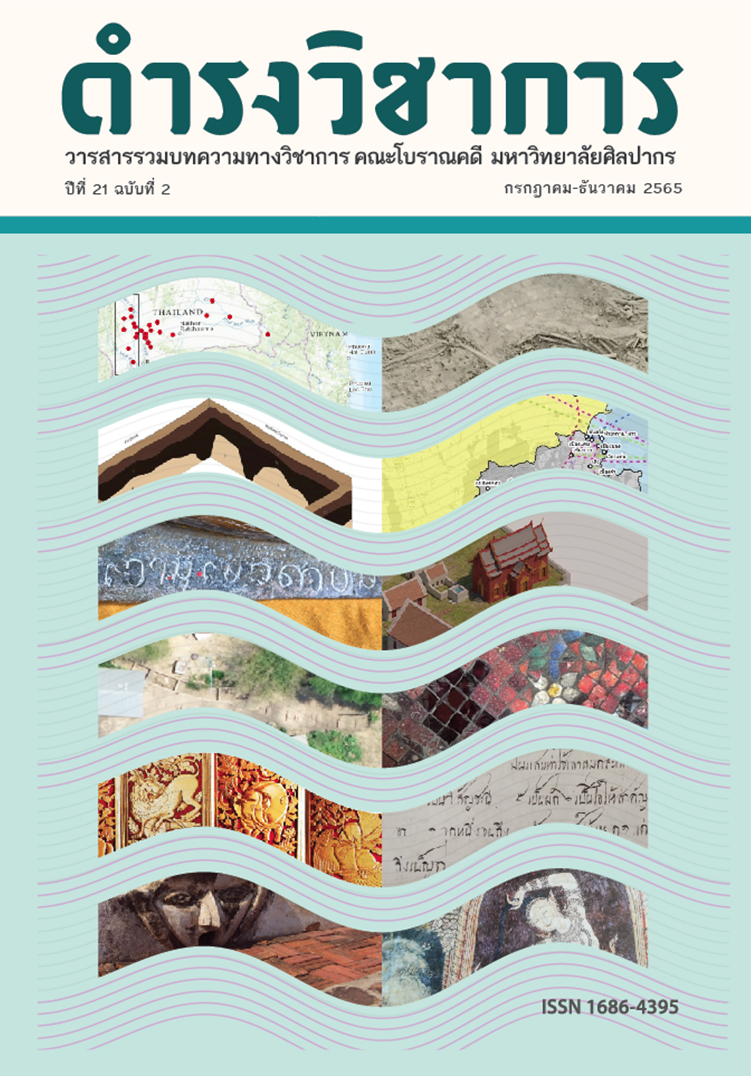The Development of Motifs in Northeastern Thai Ordination Halls in Thailand before 1940
Keywords:
Development motifs, Northeastern Thai, ordination halls before 1940Abstract
The decorative patterns in Isan ordination halls before 1940 in Thailand can be categorized into three groups. The first group is decorated in accordance with the culture of the late Ayutthaya period. This group is especially seen in Nakhon Ratchasima Province, where its ordination halls are generally decorated as Pum Chor Hang To or ‘lion tail’ motifs combined with Narayana on Garuda and Erawan riding Indhra patterns. The second group is a contemporary pattern influenced from the former Lan Xang culture of Laos, normally seen along the Mekong River. Its highlight is a drooping Phaeng Sarai with gardenia-motif carving. The third group comes from Vietnamese handiwork focusing on auspicious patterns, e.g. leaves and flowers, bats, tigers, Prajam Yam and others, which are believed to bring about prosperity and longevity to sightseers. Apexes of ordination halls in this group are also decorated as dragon motifs representing the Lord Buddha, the leader and founder of Buddhism.
Results acquired from analysis of Isan-historical evidence indicated that factors effecting Isan ordination halls on pattern creation, prototype origins, development and sequels are consistent with sequences of historical periods, i.e. Ayutthaya, former Lan Xang of Laos, and Rattanakosin, respectively. The study also shows Isan historical art in the former time in terms of handicraft succession, which may later lead to guidelines for conserving and developing our country’s artistic traditions.
References
จิตรา ก่อนันทเกียรติ, 2558. บ่วง สื่อ ยู่ อ่ี ทุกเรื่องสมปรารถนา. กรุงเทพฯ: แปลนพริ้นติ้ง.
ชวลิต อธิปัตยกุล, 2556. สิมญวนในอีสาน: ความโยงใยพัฒนาการที่มา ที่ไป และสิ้นสุดในห้วงมิติเวลาบนภาคอีสาน
ของประเทศไทย. อุดรธานี: เต้า-โล้.
____________, 2558. สิมรูปแบบฝีมือช่างญวน 161 หลัง กับช่วงเวลาหนึ่งในภาคอีสาน. อุดรธานี: เต้าโล้.
____________, 2559. ศิลปะอีสาน: จากวัฒนธรรมก่อนประวัติศาสตร์ถึงปัจจุบันโดยสังเขป. อุดรธานี: เต้า-โล้.
ธวัชชัย ดุลยสุจริต, 2545. สัญลักษณ์มงคลจีน สืบสาน จิต-วิญญาณบรรพชน. กรุงเทพฯ: สร้างสรรค์บุ๊คส์.
ประทุม ชุ่มเพ็งพันธ์ุ, 2544. สัตว์มงคลจีน ประเพณีและความเชื่อจากอดีตถึงปัจจุบัน. กรุงเทพฯ: ชมรมเด็ก.
พจนานุกรมฉบับราชบัณฑิต, 2556. กรุงเทพฯ: นานมีบุ๊ค.
พรพรรณ จันทโรนานนท์, 2547. ฮก ลก ซิ่ว โชค ลาภ อายุยืน. กรุงเทพฯ: มติชน.
สันติ เล็กสุขุม, 2546. ลีลาไทย เพื่อความเข้าใจความคิดเห็นของช่างโบราณ. กรุงเทพฯ: มติชน.
Downloads
Published
Issue
Section
License
Copyright (c) 2022 Damrong Journal of The Faculty of Archaeology Silpakorn University

This work is licensed under a Creative Commons Attribution-NonCommercial-NoDerivatives 4.0 International License.
บทความนี้เป็นผลงานของข้าพเจ้าแต่เพียงผู้เดียว และ/หรือเป็นผลงานของข้าพเจ้าและผู้ร่วมงาน ตามชื่อที่ระบุในบทความจริง และเป็นผลงานที่มิได้ถูกนำเสนอหรือตีพิมพ์ที่ใดมาก่อน





